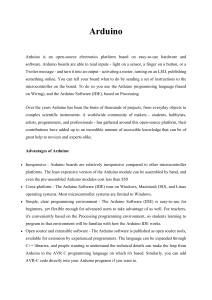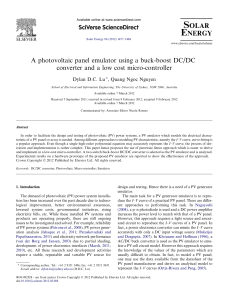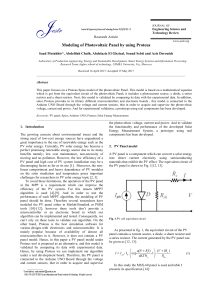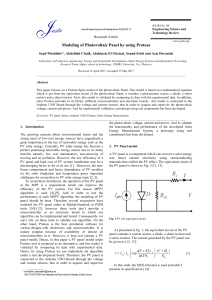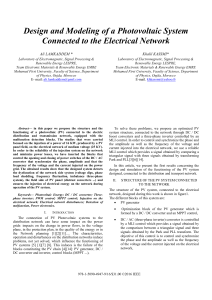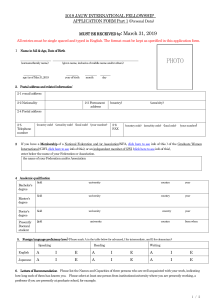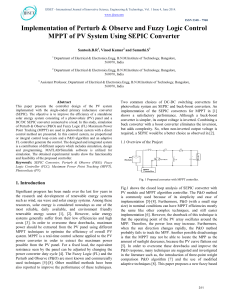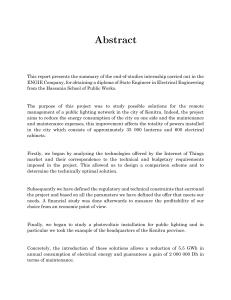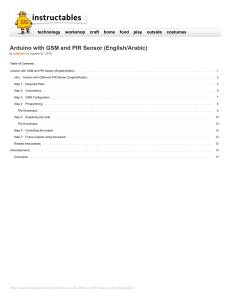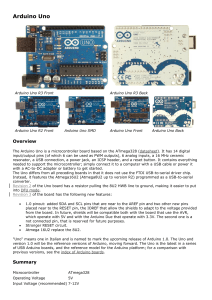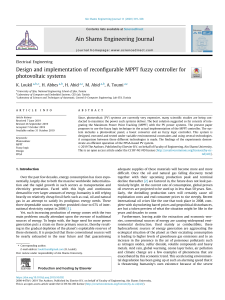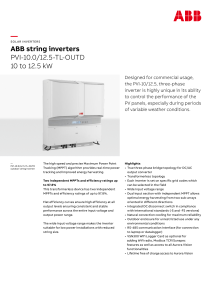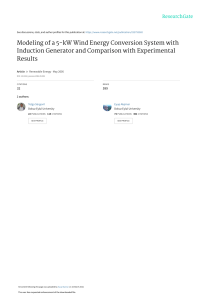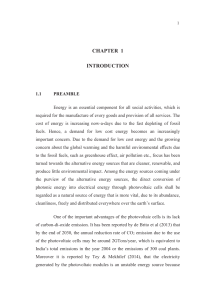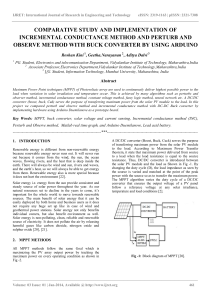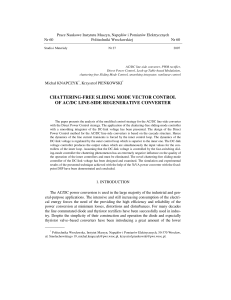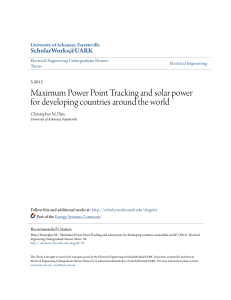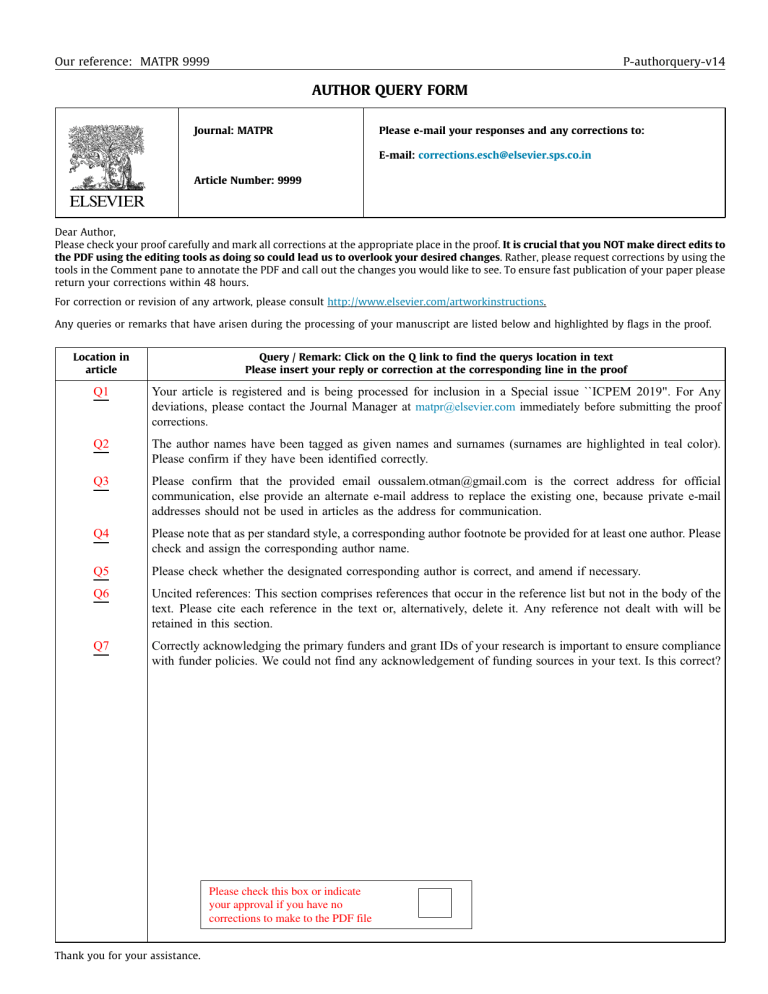
Our reference: MATPR 9999 P-authorquery-v14 AUTHOR QUERY FORM Journal: MATPR Please e-mail your responses and any corrections to: E-mail: [email protected] Article Number: 9999 Dear Author, Please check your proof carefully and mark all corrections at the appropriate place in the proof. It is crucial that you NOT make direct edits to the PDF using the editing tools as doing so could lead us to overlook your desired changes. Rather, please request corrections by using the tools in the Comment pane to annotate the PDF and call out the changes you would like to see. To ensure fast publication of your paper please return your corrections within 48 hours. For correction or revision of any artwork, please consult http://www.elsevier.com/artworkinstructions. Any queries or remarks that have arisen during the processing of your manuscript are listed below and highlighted by flags in the proof. Location in article Query / Remark: Click on the Q link to find the querys location in text Please insert your reply or correction at the corresponding line in the proof Q1 Your article is registered and is being processed for inclusion in a Special issue ``ICPEM 2019". For Any deviations, please contact the Journal Manager at [email protected] immediately before submitting the proof corrections. Q2 The author names have been tagged as given names and surnames (surnames are highlighted in teal color). Please confirm if they have been identified correctly. Q3 Please confirm that the provided email [email protected] is the correct address for official communication, else provide an alternate e-mail address to replace the existing one, because private e-mail addresses should not be used in articles as the address for communication. Q4 Please note that as per standard style, a corresponding author footnote be provided for at least one author. Please check and assign the corresponding author name. Q5 Please check whether the designated corresponding author is correct, and amend if necessary. Q6 Uncited references: This section comprises references that occur in the reference list but not in the body of the text. Please cite each reference in the text or, alternatively, delete it. Any reference not dealt with will be retained in this section. Q7 Correctly acknowledging the primary funders and grant IDs of your research is important to ensure compliance with funder policies. We could not find any acknowledgement of funding sources in your text. Is this correct? Please check this box or indicate your approval if you have no corrections to make to the PDF file Thank you for your assistance. MATPR 9999 No. of Pages 7, Model 5G 8 August 2019 Materials Today: Proceedings xxx (xxxx) xxx 1 Contents lists available at ScienceDirect Materials Today: Proceedings journal homepage: www.elsevier.com/locate/matpr 5 6 4 Q1 A low cost controller of PV system based on Arduino board and INC algorithm 7 Q2 O. Oussalem ⇑, M. Kourchi, A. Rachdy, M. Ajaamoum, H. Idadoub, S. Jenkal 8 Q3 LASIME (Engineering Science and Energy Management Laboratory) ENSA, Agadir, Morocco 9 a r t i c l e 3 1 4 1 2 12 13 14 15 16 17 18 19 20 21 22 23 i n f o Article history: Received 4 June 2019 Received in revised form 20 July 2019 Accepted 24 July 2019 Available online xxxx Keywords: PV MPPT Arduino Incremental conductance (INC) Matlab-Simulink a b s t r a c t Photovoltaic (PV) systems offer a very competitive solution as an alternative energy source, but they have a low efficiency. To overcome the problem of solar panel performance and achieve maximum efficiency, it is necessary to optimize the design of all parts of the PV photovoltaic chain. Then we insert a stage of adaptation between the photovoltaic generator (GPV) and the load. This stage which is controlled by a microcontroller, will allow the system to search and reach the maximum power point (MPP). This algorithm is among of other ones which are widely used in PV systems for their easy implementation as well as their low cost. This algorithm was analyzed and its performance was evaluated by using the Arduino board via Matlab-Simulink tool. Ó 2019 Elsevier Ltd. All rights reserved. Selection and peer-review under responsibility of the scientific committee of the International Conference on Plasma and Energy Materials ICPEM2019. 25 26 27 28 29 30 31 32 33 34 35 36 37 38 39 1. Introduction 40 In line with, its energy strategy which aims to achieve energy independence, Morocco has accorded high priority to convert to the renewable energies and especially solar thermal and photovoltaic energy [1]. Photovoltaic energy is a solution for the production of renewable energy based on a photovoltaic generator (GPV) from the solar flux. In its operation a GPV has non-linear characteristics, which depend among other things on the illumination, the temperature of the cell and also on the characteristics of the charge. An adaptive stage is inserted between the GPV and the load. This stage allows driving the system to the maximum power point (MPP). The aim of this work is the design and realization for the control of different parties of a photovoltaic system by low cost board (Arduino board) via the Matlab-Simulink software. The PV system is customized by an ‘‘incremental” strategy which is a type of MPPT algorithms that will ensure the achievement of the maximum power provided by the PV module [2,3]. Various results are presented in this article in order to validate this control platform as being the most cost-effective and efficient for the optimization of the photovoltaic chain. 41 42 43 44 45 46 47 48 49 50 51 52 53 54 55 56 57 58 59 Q5 ⇑ Corresponding author. E-mail address: [email protected] (O. Oussalem). This article is divided into five parts: After the introduction, the second part gives a general description of a photovoltaic system. The third part deals with the interface based on the Arduino board under the Matlab-Simulink environment. The fourth one will be dedicated to the experimental results of the system studied. Finally, this study finishes with a conclusion. 60 2. Photovoltaic system 66 The photovoltaic system under study consists of four blocks as shown in Fig. 1. The first block represents the photovoltaic emulator, the second block is the static converter DC-DC Buck-Boost, the third block represents the DC load and the fourth one is the system controller. 67 2.1. PV emulator 72 The PV panels are depends on climatic conditions, that’s why we chose to employ a PV emulator. This PV emulator is an electronic power system able to reproduce the characteristics of the solar panel, and which has the following characteristics [4]: 73 It consists of three independent blocks emulating solar panels; Voltage of open circuit is 20 V; Short-circuit current up to 2 A; 78 https://doi.org/10.1016/j.matpr.2019.07.689 2214-7853/Ó 2019 Elsevier Ltd. All rights reserved. Selection and peer-review under responsibility of the scientific committee of the International Conference on Plasma and Energy Materials ICPEM2019. Please cite this article as: O. Oussalem, M. Kourchi, A. Rachdy et al., A low cost controller of PV system based on Arduino board and INC algorithm, Materials Today: Proceedings, https://doi.org/10.1016/j.matpr.2019.07.689 61 62 63 64 65 68 69 70 71 74 75 76 77 79 80 MATPR 9999 No. of Pages 7, Model 5G 8 August 2019 2 O. Oussalem et al. / Materials Today: Proceedings xxx (xxxx) xxx Fig. 1. Schematic diagram of PV system with MPPT. 81 82 83 84 Displays voltage and current variables on integrated displays for each of the three blocks; Simulation adjustable intensities of solar irradiation, each of the three blocks. Fig. 3. The characteristic I (V) of the PV emulator for G = 400 w/m2. 85 87 For an irradiation of 400 W/m2, the characteristics (I–V) and (P– V) of the photovoltaic emulator are illustrated in Figs. 2 and 3. 88 2.2. Static converter 89 The main role of the Buck-Boost power converter is to ensure impedance matching, so that the output of the PV emulator delivers the maximum energy. The electronic circuit corresponding to the Buck-Boost realized (Fig. 4), is essentially based around the power MOSFET transistor, type IRF730, driven by the Arduino control board via a driver, as well as a diode, and passive components (L, C) ensuring the smoothing and filtering of the current electric [5]. The main variables characterizing the Buck-Boost converter [5,6] are: 86 90 91 92 93 94 95 96 97 98 99 101 The output voltage is : V s ¼ 102 104 The output current is : Is ¼ a 1a 1a a Ve Ie Fig. 4. Circuit of Buck-Boost converter. ð1Þ The current ripple : DIL ¼ ð2Þ The voltage ripple : DV C ¼ 105 aV e ð3Þ Lf aIs Cf ¼ a2 V e ð1 aÞRCf 108 ð4Þ With: 107 110 111 a: The duty cycle of the PWM signal or PWM. f: The frequency of the PWM signal. VC: voltage across the capacitor. IL: current through the coil. R: resistive load. L and C: inductor and capacitor constituting the filter. The filter values are: L 0.9 mH and C 27 mF. 112 113 114 115 116 117 118 119 Fig. 2. The characteristic P (V) of the PV emulator for G = 400 W/m2. 2.3. PWM generator 120 There are a lot of generators of PWM signal, the used one is based on the TL494 component. This is an integrated circuit of pulse width modulation control for fixed frequency signals. The circuit accompanying the TL494 component is described in the electrical schema of Fig. 5 [7]. This generator can operate at frequencies up to 400 kHz. According to technical documents of TL494 builder, the approximate oscillation frequency is determined by [7]: 121 1:1 fc ¼ Rt C t ð5Þ Please cite this article as: O. Oussalem, M. Kourchi, A. Rachdy et al., A low cost controller of PV system based on Arduino board and INC algorithm, Materials Today: Proceedings, https://doi.org/10.1016/j.matpr.2019.07.689 122 123 124 125 126 127 128 129 131 MATPR 9999 No. of Pages 7, Model 5G 8 August 2019 O. Oussalem et al. / Materials Today: Proceedings xxx (xxxx) xxx 3 Fig. 5. PWM generator based on the TL494 circuit. 132 133 134 135 136 137 138 139 140 141 The duty cycle of the PWM signal is controlled by a voltage that varies from 0 V to 2.5 V. The Mosfet used must be controlled by a PWM signal greater than 7 V, for that reason, a driver was realized for amplifying the signal of the PWM generator. To follow the MPP, the platform needs two sensors: current and voltage sensor. The voltage measurement is performed from a voltage divider to have a voltage between 0 and 5 V. The output of this divider drives a follower amplifier realized by the circuit ‘‘LM324” to the impedance matching. However the current measurement is done by a shunt resistor of 1 X. 142 3. MPPT strategy and support package for Arduino board 143 The strategy of maximizing the power from a photovoltaic source is to seek the optimum operating point. This technique is called: the MPPT strategy. There are several types of MPPT strategies, among which is the incremental conductance (INC) command, which this technique is 144 145 146 147 based on the knowledge of the GPV Conductor Variation and Position Consequences operation in relation to a MPP [8]. Fig. 6 shows that the maximum power can then be tracked by making comparisons to each moment of the value of the conductance (Ipv/Vpv) with that of the increment ofConductance (DIpv/DVpv). Vr corresponds to the reference voltage and forces the GPV to operate at this value. If you are at the PPM, then the voltage Vr corresponds well to the optimum voltage Vopt. Once the PPM is reached, the operation can be maintained on this position until a variation of DIpv. This then indicates a change in climatic conditions, so a new MPCs search. For this, the algorithm increments or decrements the value of Vr up to reach the MPP [9]. Matlab (Matrix laboratory) is a fourth-generation programming language, developed by MathWorks. Matlab has provided a tool books for Arduino called the support package, which includes a Simulink block library to configure and access the sensors, actuators and Arduino communication interfaces [2,3]. Fig. 6. Conventional flow chart of the MPPT control type ‘incremental conductance’. Please cite this article as: O. Oussalem, M. Kourchi, A. Rachdy et al., A low cost controller of PV system based on Arduino board and INC algorithm, Materials Today: Proceedings, https://doi.org/10.1016/j.matpr.2019.07.689 148 149 150 151 152 153 154 155 156 157 158 159 160 161 162 163 164 165 MATPR 9999 No. of Pages 7, Model 5G 8 August 2019 4 O. Oussalem et al. / Materials Today: Proceedings xxx (xxxx) xxx 167 This developed configuration (Fig. 7) is for the treaty system, based on the Simulink environment. 168 4. Experimental result 166 169 170 171 172 173 174 175 176 177 178 179 180 The experimental realization of the photovoltaic system under study, as shown in the Fig. 8, is composed of a PV emulator, a Buck-Boost chopper, sensors of Ipv (PV emulator current) and Vpv (PV emulator voltage), a resistive load, and an Arduino Mega board. The experimental test of the studied system should start by attacking the Arduino board, by the program of the ‘incremental conductance’ strategy treated previously. It is noted that during the experimental process, some adaptations and calibrations were made between the various variables treated in the photovoltaic system. Thus the system can search for and converge towards the point of maximum power. The PV emulator offers the possibility to choose the G value of the irradiation by selecting one of the two values 400 and 600 W/m2, in order to see the influence of the ‘incremental conductance’ strategy on the PV emulator’s output power (Ppv). Fig. 9 describes the evolution of the PV emulator’s output power for the irradiation G = 400 W/m2. Those figures illustrate the curves of the PV emulator’s output power Ppv as a function of the time and of the voltage Vpv. These curves are processed in order to show that the photovoltaic system realized was able to seek and follow the power supplied and to reach the output power around the maximum power point (MPP) at around 13 W for an irradiation of G = 400 w/m2. It is also remarkable in Fig. 10, that the system following its curves of the PV emulator’s output power in function of the voltage and of the time, behaves by the same way in a second test for irradiation G = 600 w/m2. So it was able to reach the output power around its new maximum power point (around of 16 W). Fig. 7. Control Simulink interface. Fig. 8. The parts of the designed PV chain. Please cite this article as: O. Oussalem, M. Kourchi, A. Rachdy et al., A low cost controller of PV system based on Arduino board and INC algorithm, Materials Today: Proceedings, https://doi.org/10.1016/j.matpr.2019.07.689 181 182 183 184 185 186 187 188 189 190 191 192 193 194 195 196 197 MATPR 9999 No. of Pages 7, Model 5G 8 August 2019 O. Oussalem et al. / Materials Today: Proceedings xxx (xxxx) xxx 5 Fig. 9. The curves of the system in function of voltage and time for G = 400 W/m2. Fig. 10. The PPM of the system the in function of voltage and of the time for G = 600 W/m2. Fig. 11. The curves of the system the in function of voltage and of the time when changing G from 400 W/m2to 600 W/m2. Please cite this article as: O. Oussalem, M. Kourchi, A. Rachdy et al., A low cost controller of PV system based on Arduino board and INC algorithm, Materials Today: Proceedings, https://doi.org/10.1016/j.matpr.2019.07.689 MATPR 9999 No. of Pages 7, Model 5G 8 August 2019 6 O. Oussalem et al. / Materials Today: Proceedings xxx (xxxx) xxx 209 The interest by changing the irradiation G suddenly from 400 W/m2 to 600 W/m2, is to observe the system behaviour at this immediate change of the irradiation and following its robustness to reach its maximum power point, the system give a tool to investigate the efficiency of this realization carried out. As illustrated in Fig. 11 and by only the both irradiations tested. The system looks for and follows the new values of the maximum power as shows in those curves of PV emulator’s output power as a function of the voltage and of the time. The power then reaches around the respective values 13 W and 16 W. So those values are quite well correlated with the maximum powers in the static case presented previously. 210 5. Conclusion 211 In this study, a low cost controller has been developed to track the maximum power point of PV system by INC strategy using Arduino board via Matlab/Simulink as an interface of the control. PV emulator with two sensors, buck-boost converter connected to a resistive load has been also used. It is found that the INC algorithm is easily implemented with minimal of component and with fast convergence around the desired MPP. According to the results obtained from the practical tests of a control realized platform. The proposed system showed its ability to reach MPP under uniform and sudden changes of irradiation. Thus, the platform controlled by the ‘‘incremental conductance” strategy, based on the Arduino board via Matlab-Simulink, is corroborated as a cost-effective device for optimizing photovoltaic chain. 198 199 200 201 202 203 204 205 206 207 208 212 213 214 215 216 217 218 219 220 221 222 223 224 225 As a perspective to this work, it is recommended to develop this realization for different types of PV modules, for different MPPT strategies and via different electronic boards. Uncited reference [10]. 226 227 228 Q6 229 Q7 230 References 231 [1] Appui a la politique energetique du maroc, www.giz-energy.ma. [2] Latrache soufian, Bouzid kheir Eddine, Design and Realization of a photovoltaic system based on an Arduino uno professional master memory university kasdi merbah ouargla, 2015/2016. [3] Bouderhim Brahim, Salhi Younis’ design and implementation of a chopper boost MPPT based on an Arduino board, Professional master memory university kasdi merbah – ouargla 2016/2017. [4] Emuril Akbar, Bin Shaari, R.T. Naaygi, Performance evaluation of solar modules using Lucas-Nulle Emulator, Int. J. Environ. Sci. (2018). [5] Hamid Maçbahi, Power factor correction in a resonant converter with active method thesis master, Université du Québec à Trois-Rivières, 1996. [6] Edric Cabal, Energy optimization of the electronic adaptation floor dedicated to conversion PhD Thesis, University of Toulouse III Paul Sabatier, France, 2008. [7] Texas Instrument, TL494 Pulse with modulation control circuit, SLSO74HJanuary 1983–Revised March 2017. [8] M. Ajaamoum, M. Kourchi, R. Alaoui, L. Bouhouch, Fuzzy controller to extract the maximum power of a photovoltaic system, Renewable and Sustainable Energy Conference International (IRSEC), IEEE, 2013, pp. 141–146. [9] N. Debili, Study and optimization in Matlab/Simulink environment of a photovoltaic pumping system Magister Thesis, University Mentouri, Constantine, Algeria, 2015. [10] Borni Abdelhalim, Study and control of a circuit for extracting the maximum power from a solar panel Magister Thesis, Mentouri University of Constantine, Algeria, 2009. 232 233 234 235 236 237 238 239 240 241 242 243 244 245 246 247 248 249 250 251 252 253 254 255 Please cite this article as: O. Oussalem, M. Kourchi, A. Rachdy et al., A low cost controller of PV system based on Arduino board and INC algorithm, Materials Today: Proceedings, https://doi.org/10.1016/j.matpr.2019.07.689 256
